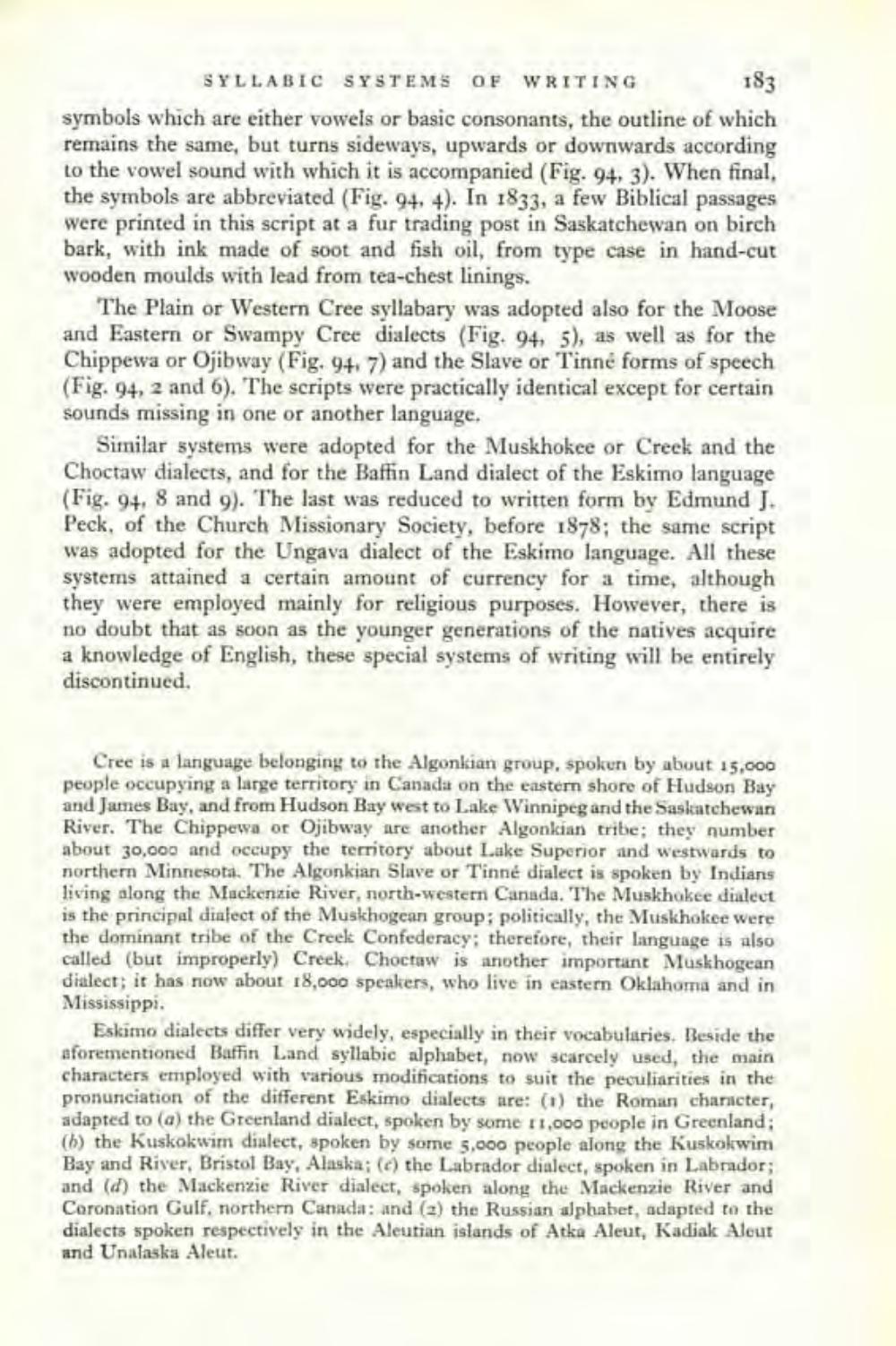________________
SYLLABIC SYSTEMS OF WRITING
183 symbols which are either vowels or basic consonants, the outline of which remains the same, but turns sideways, upwards or downwards according to the vowel sound with which it is accompanied (Fig. 94, 3). When final, the symbols are abbreviated (Fig. 94, 4). In 1833, a few Biblical passages were printed in this script at a fur trading post in Saskatchewan on birch bark, with ink made of soot and fish oil, from type case in hand-cut wooden moulds with lead from tea-chest linings.
The Plain or Western Cree syllabary was adopted also for the Moose and Eastern or Swampy Cree dialects (Fig. 94, 5), as well as for the Chippewa or Ojibway (Fig. 94, 7) and the Slave or Tinne forms of speech (Fig. 94, 2 and 6). The scripts were practically identical except for certain sounds missing in one or another language.
Similar systems were adopted for the Muskhokee or Creek and the Choctaw dialects, and for the Baffin Land dialect of the Eskimo language (Fig. 94, 8 and 9). The last was reduced to written form by Edmund J. Peck, of the Church Missionary Society, before 1878; the same script was adopted for the Ungava dialect of the Eskimo language. All these systems attained a certain amount of currency for a time, although they were employed mainly for religious purposes. However, there is no doubt that as soon as the younger generations of the natives acquire a knowledge of English, these special systems of writing will be entirely discontinued.
Cree is a language belonging to the Algonkian group, spoken by about 15.000 people occupying a large territory in Canada on the eastern shore of Hudson Bay and James Bay, and from Hudson Bay west to Lake Winnipeg and the Saskatchewan River. The Chippewa or Ojibway are another Algonkian tribe; they number about 30,000 and occupy the territory about Lake Superior and westwards to northern Minnesota. The Algonkian Slave or Tinné dialect is spoken by Indians living along the Mackenzie River, north-western Canada. The Muskhokee dialect is the principal dialect of the Muskhogean group; politically, the Muskhokee were the dominant tribe of the Creek Confederacy; therefore, their language is also called (but improperly) Creek. Choctaw is another important Muskhogean dialect; it has now about 18,000 speakers, who live in eastern Oklahoma and in Mississippi.
Eskimo dialects differ very widely, especially in their vocabularies. Beside the aforementioned Baffin Land syllabic alphabet, now scarcely used, the main characters employed with various modifications to suit the peculiarities in the pronunciation of the different Eskimo dialects are: (1) the Roman character, adapted to (a) the Greenland dialect, spoken by some 11,000 people in Greenland; (h) the Kuskokwim dialect, spoken by some 5,000 people along the Kuskokwim Bay and River, Bristol Bay, Alaska; (c) the Labrador dialect, spoken in Labrador; and (d) the Mackenzie River dialect, spoken along the Mackenzie River and Coronation Gulf, northern Canada: and (2) the Russian alphabet, adapted to the dialects spoken respectively in the Aleutian islands of Atka Aleut, Kadiak Aleur and Unalaska Aleut.




